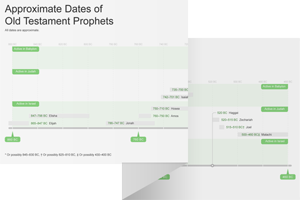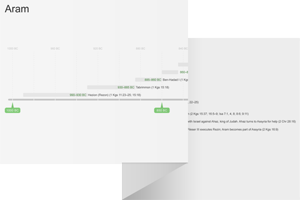1:1 The opening verse places Amos’ ministry in the eighth century bc, contemporary with Hosea, Isaiah, and Micah. Amos |
Amos Means “burdensome” or “burden-bearer.”
 Prophetic Commissioning and the Divine Presence
Prophetic Commissioning and the Divine Presence
Nothing is known about the prophet Amos apart from what can be learned from the book bearing his name. He was from the village of Tekoa, |
the shepherds Amos is no ordinary shepherd. The Hebrew term used here occurs only one other time in the ot, where it refers to Mesha, king of Moab, as a someone who bred sheep (2 Kgs 3:4).
as a someone who bred sheep (2 Kgs 3:4).
Tekoa A town in the hill country of Judah about 10 miles south of Jerusalem. See note on Jer 6:1.
Uzziah the king of Judah Though the precise dates of Uzziah’s reign are debated, he ruled in the first half of the eighth century, roughly 790–740 bc.
Jeroboam the son of Jehoash Reigned 786–746 bc. See note on Hos 1:1.
two years before the earthquake The reference to Amos’ ministry occurring “two years before the earthquake” was likely intended to more firmly orient his preaching to a memorable event. Earthquakes are not rare in Israel, so this particular earthquake must have been especially damaging or violent.
1:2–2:3 Amos opens with an oracle of judgment against Israel’s neighbors. The prophets regularly use oracles against the nations to emphasize Yahweh’s judgment coming on Israel’s enemies. These oracles are often placed after emphatic pronouncements of doom on Israel and Judah, reassuring Israel that the nations used to judge them will in turn be judged by Yahweh. Amos uses the rhetoric of judgment against the nations to the opposite effect, lulling his audience into complacent agreement with his introductory vision and shocking them when it culminates in an oracle of doom for Israel and Judah, using the same formulaic imagery (Amos 2:4–5). |
1:2 Yahweh roars from Zion An image of divine wrath emphasizing Yahweh’s dwelling place was Mount Zion, the temple mount in Jerusalem.
Carmel Likely referring to Mount Carmel, which marked the northwest border of Israel. The mountain was the setting for Elijah’s confrontation with the prophets of Baal in 1 Kgs 18. See note on Jer 46:18.
which marked the northwest border of Israel. The mountain was the setting for Elijah’s confrontation with the prophets of Baal in 1 Kgs 18. See note on Jer 46:18.
1:3 For three transgressions of Damascus and for four This formula, with different cities mentioned, functions as a refrain throughout this section (Amos 1:6, 9, 11, 13; 2:1, 4, 6).
Damascus The chief city of Aram
of Aram (also called Syria), the nation north of Israel. It was the capital during the 10th–8th centuries bc before falling to Assyria in 732 bc.
(also called Syria), the nation north of Israel. It was the capital during the 10th–8th centuries bc before falling to Assyria in 732 bc.
threshing sledges of iron Driven over harvested grain to separate the kernels from the stalks and chaff. See note on Isa 28:27.
Gilead A fertile region of the northern Transjordan, one of the areas of Israel closest to Damascus. See note on Jer 8:22.
See note on Jer 8:22.
1:4 Hazael’s house An Aramean king who founded a new dynasty by assassinating the previous king in 842 bc (2 Kgs 8:7–15). Hazael
king who founded a new dynasty by assassinating the previous king in 842 bc (2 Kgs 8:7–15). Hazael was Aram’s
was Aram’s most powerful king and frequently threatened Israel and Judah (2 Kgs 12:17–18; 13:3).
most powerful king and frequently threatened Israel and Judah (2 Kgs 12:17–18; 13:3).
Ben-Hadad The name of at least two kings of Damascus. This reference probably applies to the Ben-hadad who was the son and successor of Hazael (2 Kgs 13:24–25).
(2 Kgs 13:24–25).
1:5 the Valley of Aven Possibly refers to the plain in Syria between the Lebanon
between the Lebanon and Anti-Lebanon mountain ranges.
and Anti-Lebanon mountain ranges.
Beth Eden An Aramean state west of Haran (also rendered “Harran”) known in Assyrian sources as Bit Adini. Compare Ezek 27:23.
Aram The names Aram and Syria both refer primarily to the region controlled by Damascus.
Kir Probably a location in Mesopotamia. According to Amos 9:7, the Arameans originated in Kir. See note on Isa 22:6.
1:6 Gaza One of the five cities of the Philistines.
of the five cities of the Philistines. Three more cities from the Philistine pentapolis
Three more cities from the Philistine pentapolis are mentioned in Amos 1:8—Ashdod,
are mentioned in Amos 1:8—Ashdod, Ashkelon,
Ashkelon, and Ekron.
and Ekron. See note on Jer 25:20, and note on 1 Sam 4:1.
See note on Jer 25:20, and note on 1 Sam 4:1.
they exiled a whole community Probably alluding to Philistine involvement in the slave trade, though the precise historical background is uncertain.
though the precise historical background is uncertain.
Edom Judah’s neighbor to the southeast. See note on Jer 25:21.
1:9 transgressions of Tyre A Phoenician seaport located northwest of Israel. See note on Ezek 26:2.
delivered up a whole community to Edom The same accusation as that against Gaza in Amos 1:6. Likely also refers to Tyre’s involvement in the slave trade (compare Ezek 27:13). See note on Amos 1:6.
the covenant of brotherhood Possibly refers to the treaty between King Solomon and King Hiram of Tyre
of Tyre (1 Kgs 5:12).
(1 Kgs 5:12).
1:11 he pursued his brother with the sword Edom’s ancestor, Esau, and Israel’s ancestor, Jacob, were brothers (see Gen 25:25–26). The two nations were frequently at war with one another (see 2 Chr 28:17), so there is no need to identify a specific historical reference here.
were brothers (see Gen 25:25–26). The two nations were frequently at war with one another (see 2 Chr 28:17), so there is no need to identify a specific historical reference here.
he kept his rage forever Edom’s transgression is slightly different as they are condemned for harboring a grudge against Israel.
1:12 Teman An important Edomite city. See note on Jer 49:7.
the citadel fortresses of Bozrah The ancient capital of Edom. See note on Jer 49:13.
of Edom. See note on Jer 49:13.
1:13 Ammon Israel’s neighbor to the east in the Transjordan.
to the east in the Transjordan. See note on Ezek 25:2.
See note on Ezek 25:2.
ripped open the pregnant women of An image of vicious destruction. Compare Hos 13:16.
enlarge their territory Ammon regularly fought over territory with Israel and Judah.
1:14 Rabbah The capital of Ammon. See note on Ezek 21:20.
of Ammon. See note on Ezek 21:20.
1:15 their king will go into exile The Hebrew text could mean “their king”; it also could be the name of the Ammonite deity Milcom
Milcom (compare Jer 49:3 and note).
(compare Jer 49:3 and note).

|
About Faithlife Study BibleFaithlife Study Bible (FSB) is your guide to the ancient world of the Old and New Testaments, with study notes and articles that draw from a wide range of academic research. FSB helps you learn how to think about interpretation methods and issues so that you can gain a deeper understanding of the text. |
| Copyright |
Copyright 2012 Logos Bible Software. |
| Support Info | fsb |
 Loading…
Loading…


 Amos
Amos 

